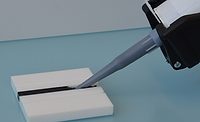Real-Time Monitoring of Adhesive and Sealant Properties
The correct adjustment of flow characteristics of sealants and thermosetting adhesives is crucial to their performance in automated, high-speed production environments.

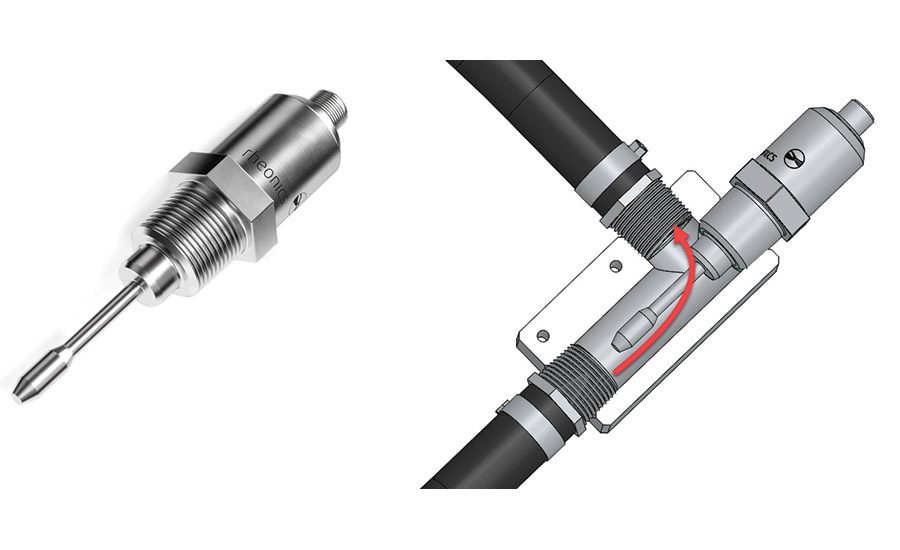
Figure 1. Inline viscometer (left) and installed in a flowline adapter for inline applications.
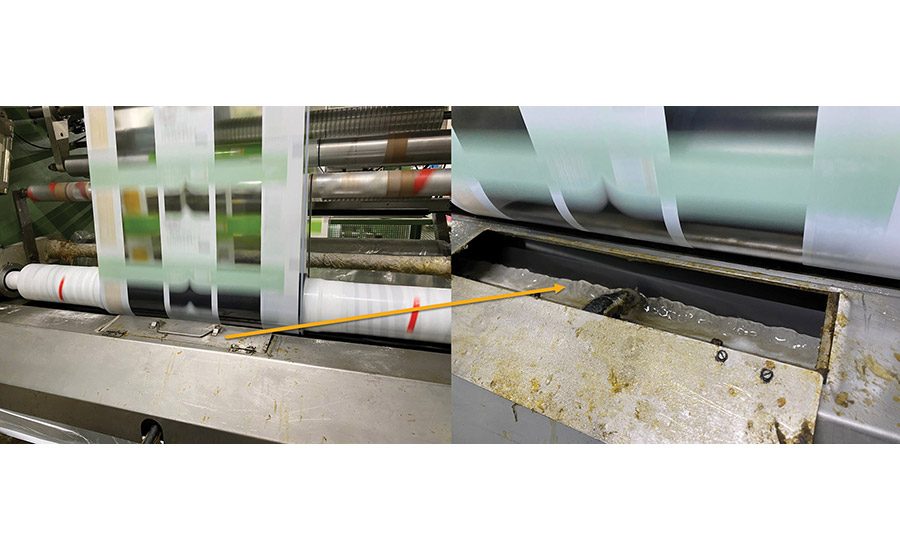
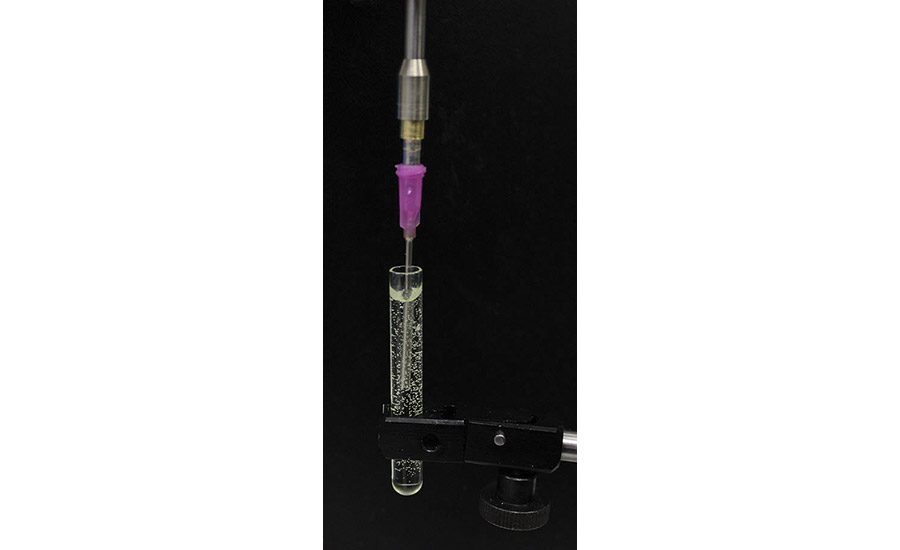
Figure 3. A device currently in testing is based on a viscosity sensor with a Luer taper on its tip to enable the connection of a conventional disposable dosing needle to extend its sensitive element.
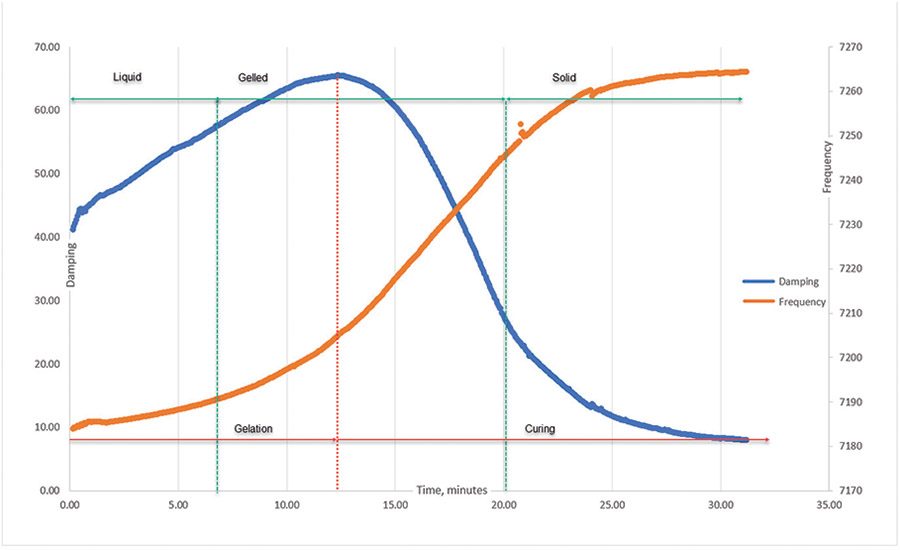
Figure 4. Curing curves of a fast-curing consumer epoxy adhesive. The plot shows the damping and frequency of the instrument with the adhesive’s liquid, gelled, and solid-cured phases.
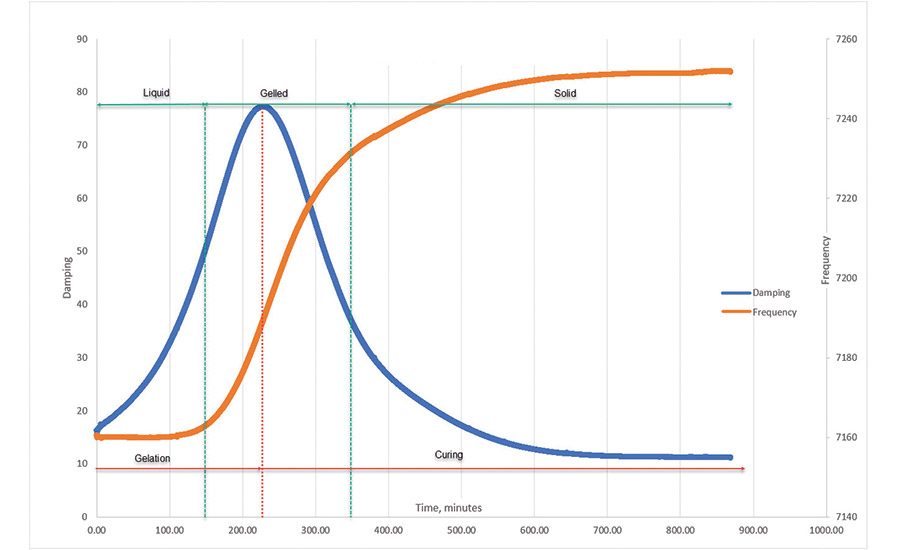
Figure 5. Curing curves of a slow-curing epoxy laminating resin with hardener in a 100:30 weight ratio. The plot shows the resin’s liquid, gelled, and solid-cured phases.
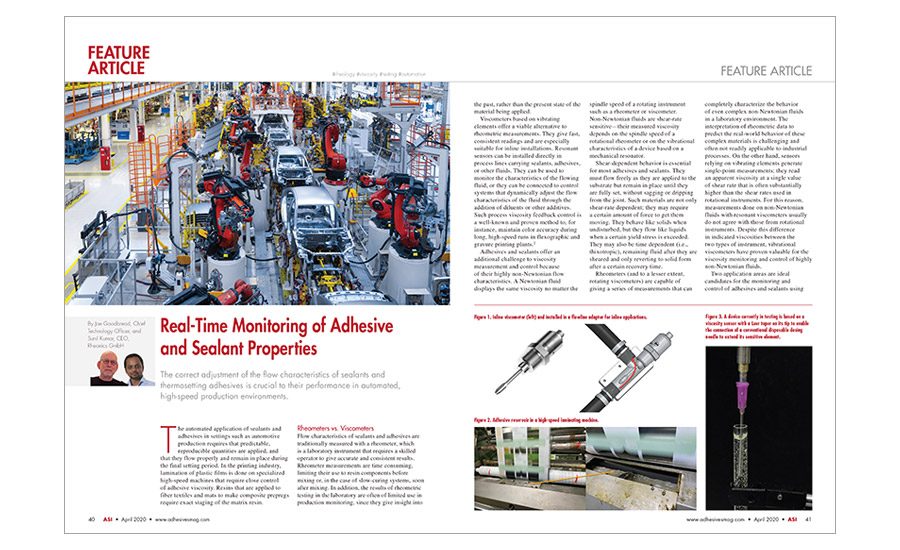
Prefer the magazine experience? Subscribe to our digital edition.







The automated application of sealants and adhesives in settings such as automotive production requires that predictable, reproducible quantities are applied, and that they flow properly and remain in place during the final setting period. In the printing industry, lamination of plastic films is done on specialized high-speed machines that require close control of adhesive viscosity. Resins that are applied to fiber textiles and mats to make composite prepregs require exact staging of the matrix resin.
Rheometers vs. Viscometers
Flow characteristics of sealants and adhesives are traditionally measured with a rheometer, which is a laboratory instrument that requires a skilled operator to give accurate and consistent results. Rheometer measurements are time consuming, limiting their use to resin components before mixing or, in the case of slow-curing systems, soon after mixing. In addition, the results of rheometric testing in the laboratory are often of limited use in production monitoring, since they give insight into the past, rather than the present state of the material being applied.
Viscometers based on vibrating elements offer a viable alternative to rheometric measurements. They give fast, consistent readings and are especially suitable for inline installations. Resonant sensors can be installed directly in process lines carrying sealants, adhesives, or other fluids. They can be used to monitor the characteristics of the flowing fluid, or they can be connected to control systems that dynamically adjust the flow characteristics of the fluid through the addition of diluents or other additives. Such process viscosity feedback control is a well-known and proven method to, for instance, maintain color accuracy during long, high-speed runs in flexographic and gravure printing plants.1
Adhesives and sealants offer an additional challenge to viscosity measurement and control because of their highly non-Newtonian flow characteristics. A Newtonian fluid displays the same viscosity no matter the spindle speed of a rotating instrument such as a rheometer or viscometer. Non-Newtonian fluids are shear-rate sensitive—their measured viscosity depends on the spindle speed of a rotational rheometer or on the vibrational characteristics of a device based on a mechanical resonator.
Shear-dependent behavior is essential for most adhesives and sealants. They must flow freely as they are applied to the substrate but remain in place until they are fully set, without sagging or dripping from the joint. Such materials are not only shear-rate dependent; they may require a certain amount of force to get them moving. They behave like solids when undisturbed, but they flow like liquids when a certain yield stress is exceeded. They may also be time dependent (i.e., thixotropic), remaining fluid after they are sheared and only reverting to solid form after a certain recovery time.
Rheometers (and to a lesser extent, rotating viscometers) are capable of giving a series of measurements that can completely characterize the behavior of even complex non-Newtonian fluids in a laboratory environment. The interpretation of rheometric data to predict the real-world behavior of these complex materials is challenging and often not readily applicable to industrial processes. On the other hand, sensors relying on vibrating elements generate single-point measurements; they read an apparent viscosity at a single value of shear rate that is often substantially higher than the shear rates used in rotational instruments. For this reason, measurements done on non-Newtonian fluids with resonant viscometers usually do not agree with those from rotational instruments. Despite this difference in indicated viscosities between the two types of instrument, vibrational viscometers have proven valuable for the viscosity monitoring and control of highly non-Newtonian fluids.
Two application areas are ideal candidates for the monitoring and control of adhesives and sealants using vibrational viscometers. The first is inline viscosity monitoring for applicators, and the second is monitoring the cure for batch operations in which it is critical to detect when a mixed batch of material is approaching the end of its pot life.
Inline Viscosity Monitoring
Sealants must flow freely during the application process, but they must not run or sag after application before they are fully cured. This requires that the material’s effective viscosity be highly shear dependent, having a low viscosity under the high shear rates that occur in the lines serving the applicator and in the applicator nozzle itself, and a high viscosity (or even a yield strength) after dispensing. Despite the importance of the flow characteristics of adhesives and sealants, particularly in the case of high-speed automatic dispensing and application, little or no information is available about inline instrumentation being applied to either monitor or control adhesive and sealant consistency.
Inline viscometers have been installed in a high-speed laminating press in which viscosity control is essential (see Figure 1).* The operator of the press has tried rotational viscometers for monitoring adhesive viscosity, but this was impractical due to the fouling of the rotating parts from dried adhesive. Currently, efflux cups are used for viscosity monitoring. However, these are notably imprecise and do not provide a true inline measurement. Their use is also time consuming, making frequent measurement impractical and therefore allowing larger-than-desired fluctuations in the viscosity—and therefore the flow characteristics of the laminating adhesive.
The problem is compounded in high-speed laminating machinery because the application roller typically runs in an open trough of adhesive, from which the solvent is constantly evaporating (see Figure 2). As in the case of printing inks in flexographic and rotogravure machines, this gradual evaporation slowly raises the viscosity of the medium, requiring periodic dosing of solvent to stabilize the medium at a nearly constant viscosity to ensure proper application throughout long, high-speed runs.
Vibrational viscosity sensors include resonators that typically operate at frequencies from several hundred hertz up to tens of kilohertz, depending on the particular operating principle. Although it is not possible to determine the actual shear rate, the range of shear rates is high, equaling or exceeding those found in the dispensing equipment. For this reason, vibrational viscosity sensors are useful for monitoring the consistency of the adhesive and how it will act during the dispensing operation.
Vibrational viscometers operate by measuring the damping of a vibration induced in a mechanical resonator immersed in the fluid. Resonators used in vibrational viscometers fall into two general categories: those that vibrate transversely, such as tuning forks and cantilever beams, and those that vibrate torsionally.
Torsional resonators are particularly advantageous for measuring the higher viscosities often encountered with sealants and adhesives, since transverse vibrations tend to be more strongly damped by high-viscosity fluids. Torsional resonators also tend to be less sensitive to their proximity to the walls of pipes and other vessels, making installation options more flexible. Mechanical compactness can be advantageous when viscosities are to be measured inline with an application system, since the flow lines are often of small diameter with relatively low flow rates compared to other process applications. Since vibrational sensors tend to produce reaction forces in their mounting that can influence their sensitivity, sensors that are vibrationally balanced are particularly free from environmental influences that affect unbalanced resonators.
*SRV inline viscometer from Rheonics GmbH, based on a patented torsionally balanced resonator
Monitoring Cure in Batch-Mixed Adhesives
Monitoring of the degree of cure of adhesives and resins is important for determining whether a particular batch of material has achieved the necessary mechanical properties, rather than just relying on manufacturers’ specifications and adjustment of process parameters. This is important in molding operations to determine when it is safe to de-mold the cured part and in composite manufacturing to determine when a laminated part is fully cured.
Many methods have been published for monitoring the degree of cure, but most rely on indirect measurements (e.g., electrical or optical characteristics), rather than direct measurement of mechanical properties. Experimental ultrasound methods are available, but these tend to be limited to small samples in closely controlled conditions, since the attenuation of ultrasound waves can be quite large during curing processes.2 In addition, ultrasound measurements are typically conducted in the range of megahertz frequencies, which, for non-Newtonian materials, may not reflect their behavior at strain rates closer to those found in their real-world applications.
A device is currently being tested that predicts gelation in batches of pre-mixed adhesives and sealants.** The device is based on a viscosity sensor with a Luer taper on its tip to enable the connection of a conventional disposable dosing needle to extend its sensitive element (see Figure 3). By using a disposable extension, the sensor itself is not exposed to the adhesive; the needle can simply be detached and disposed of, along with the gelled or hardened material.
The device outputs two numbers: the damping and the frequency of the instrument’s resonator. The damping is dependent on the viscosity of the material, while the frequency depends on its rigidity. The output of the device therefore gives a snapshot of the viscoelastic behavior of the material as it goes through its gelation and curing processes.
Figure 4 and Figure 5 show the curing curves of two different epoxy systems, as recorded by the device. The first is a consumer epoxy adhesive with a thiol-based hardener. It is specified as having a 30-min cure time and is commonly sold in hobby shops for model building. The second, a resin with a hardener, is an amine-curing system used for wet layup laminated composites. The rated gelation time is 6 hrs at a resin/hardener weight ratio of 100:30 at 23°C in a lamination process in which the large surface area restricts exothermal heating and acceleration of the curing process.
The principle indicator of impending gelation is therefore a rapid rise in indicated viscosity, followed by an increase in the resonant frequency of the sensor’s resonator. These curves show two distinct processes and three regions. The processes are gelation and curing. Gelation is the process characterized by rising damping and rising frequency, reflecting an increase in both the viscosity and the rigidity of the resin. The material is moving from a liquid to a gelled state. Curing, which is characterized by decreasing damping and increasing rigidity, is the process following gelation that transforms the material from a highly viscous, sticky mass into a rigid solid. These processes also define three states that the material moves through during gelation and curing:
- A liquid region, in which the rigidity of the material is very low, reflected in the low and relatively constant frequency of the instrument’s resonator. In this region, the viscosity is also relatively low, indicated by the low value of damping.
- Gelled region, in which both rigidity and damping of the material are rising rapidly. The material in this region is sticky. It has a high viscosity that reaches a maximum, indicating the peak of the gelation process before solidification sets in. It is becoming more rigid, forming a rubbery mass before final curing.
- Solid region, where damping has once again decreased to a low and relatively constantly value. The resonator now is producing primarily elastic shearing of the material, with little dissipation due to viscous forces.
In an article reviewing the state of adhesive cure monitoring, Shimkin concludes that although numerous methods for monitoring gelation time are available, there is both a lack of a commercial instrument base and general lack of standards—and therefore of agreement—among the various measurement methods.3 Most of the methods that Shimkin discusses are indirect, such as dielectric analysis, in that they measure a property of the resin system that is correlated with its mechanical properties but do not directly measure the properties that are functionally important in the application of the resin system. In this sense, any measurement technology that directly measures properties such as gelation and solidification provides immediate, direct feedback on the state of the resin.
**Rheonics CureTrack™, currently being tested by Rheonics GmbH
Potential Applications
Direct measurement of the mechanical properties of a resin system has applications both in the laboratory and on the factory floor, where resins are mixed, applied, and cured in a production environment. In the laboratory, a robust mechanical analysis tool such as the technology discussed here can be used both for research and development and for quality control.
In the R&D lab, it can be used to analyze curing properties of new resins and formulations. Its simplicity and the use of inexpensive and disposable sensing elements makes it possible to economically analyze large numbers of samples without the risk of damaging expensive sensors or requiring extensive and time-consuming cleaning of difficult-to-remove residues. For quality control purposes, mixed resin samples can be monitored in the laboratory without time-consuming preparation or cleanup.
For quality control purposes, the robustness of the technology can move the monitoring of mixed production batches to the factory floor, as opposed to grabbing samples for laboratory analysis. Instruments can be inserted directly in a resin bucket to monitor the resin’s state as production progresses and to issue a warning alarm when gelation is impending and any remaining material must be disposed of before it solidifies.
Future development of the technology will also focus on monitoring gelation in actual production scenarios. For instance, the probe tip could be brought into contact with the surface of a resin-infused layup to monitor the state of the matrix material. Similarly, the tip of the probe could be inserted to a controlled depth in a poured molded component and removed as gelation sets in.
Since temperature is an essential factor in determining cure rates, the instrument includes a temperature sensor that measures the temperature at the probe tip. It can measure the temperature exactly where gelation and curing are being measured, enabling both the monitoring of the resin’s temperature and tracking of heat production during the curing process
For additional information, contact the lead author at joe.goodbread@rheonics.com or visit www.rheonics.com.
References
- “Viscosity Standardization in Flexographic Printing,” Flexible Packaging Technology, 4:19, January 1, 2020, https://issuu.com/reisigmedia/docs/fpt_4_2019/6?utm_source=newsletter&utm_medium=email&utm_campaign=fpt_4_out_now&utm_term=2020-01-02.
- Lionetto, F. and Maffezzoli, A., “Review Monitoring the Cure State of Thermosetting Resins by Ultrasound,” Materials, doi:10.3390/ma6093783 materials, ISSN 1996-1944, 2013, 6, 3783-3804.
- Shimkin, A.A., “Methods for the Determination of the Gel Time of Polymer Resins and Prepregs,” Russian Journal of General Chemistry, ISSN 1070-3632, 2016, Vol. 86, No. 6, pp. 1488-1493. Original Russian text published in Rossiiskii Khimicheskii Zhurnal, 2014, Vol. 58, Nos. 3-4, pp. 55-61.
Looking for a reprint of this article?
From high-res PDFs to custom plaques, order your copy today!





